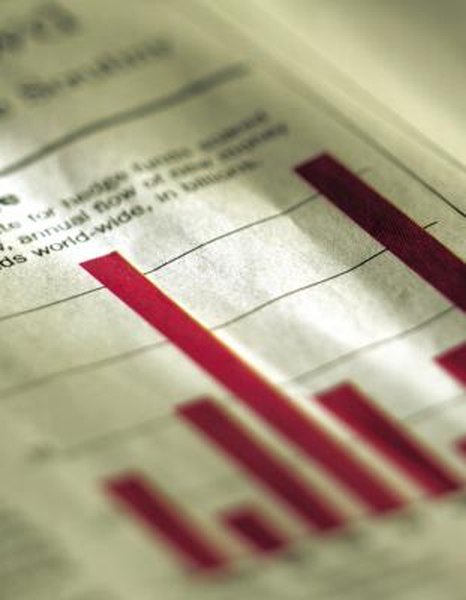Why Do Stock Market Returns Look Like a Bell Shaped Curve?
Histograms can show the frequency of returns within certain ranges.
Jupiterimages/Photos.com/Getty Images
Distributions of stock market returns are often presented as bell shaped curves. This representation implies that stock returns are normally distributed, which can depend on the period analyzed and the frequency of sampling prices to calculate returns. For example, a return distribution that contains returns realized during the financial crisis will be very different than one covering a different period. Distributions of monthly returns can look different than distributions of daily returns. Nevertheless, for many purposes, the assumption that stock returns are normally distributed is valid.
Histogram Buckets
One way to represent a distribution is with a histogram. A histogram can be created from a sample of stock returns. First, the stock returns are ordered from smallest to largest. For example, the smallest return might be negative 20 percent and the largest return might be a positive 20 percent. Next, several equal-size buckets are created. If you create 20 buckets ranging from negative 20 percent to positive 20 percent, each bucket has a range of 2 percent. The first bucket goes from less than minus 20 percent to minus 18 percent. The second bucket covers less than minus 18 percent to minus 16 percent.
Histogram Frequencies
Next, the number of returns within each bucket range is recorded. For example, in a sample of 100 ordered returns, if the first four returns are minus 20 percent, minus 19 percent, minus 17 percent and minus 15.5 percent, and the buckets have a range of 2 percent, the first bucket has a frequency of two and the second bucket has a frequency of one. This process is continued for each of the twenty buckets. The frequencies are plotted on the vertical axis in a bar chart and the ranges are ordered on the horizontal axis.
Histograms and Probability Distributions
If each return frequency is converted to a percent of the total sample, the histogram can be interpreted as a probability distribution. For a sample size of 100 returns and a frequency of two returns in the first bucket, the first bar is converted to 2/100, or 2 percent, instead of the frequency, two. Some histograms are crude representations of the true distribution of returns because they do not contain enough buckets. For very large samples and small bucket sizes, the probability distribution becomes smoother. Then, if the distribution of returns is close to a normal distribution, connecting the tops of each bar will trace out a bell curve.
Characteristics of Normal Distributions
The normal distribution, also called a Gaussian distribution, is symmetric. The expected value, or mean of the sample, is the most frequently observed value in the middle of the distribution. The width of a normal distribution is described by a statistic known as the standard deviation. For stock returns, standard deviation is often called volatility. If returns are normally distributed, more than 99 percent of the returns are expected to fall within three standard deviations of the mean. These characteristics of the bell shaped normal distribution allow analysts and investors to make statistical inferences about the expected return and risk of stocks.
Non-Normal Return Distributions
Normal return distributions are often observed, but sometimes the distribution is not symmetrical and is said to be skewed. Investors do not like negatively skewed distributions because they imply a greater probability of negative returns. Sometimes the probability of the returns in the center of the distribution is smaller than in a normal distribution. This means that the ends (or tails) of the distribution are relatively fatter, with higher probabilities of extreme returns. It indicates something called leptokurtosis, and is associated with risky “black swan” events, a term popularized by Nassim Taleb to describe unexpected events that affect returns. Whenever there is significant "skewness" or kurtosis, the return distribution departs from the normal distribution, complicating statistical inferences on the analysis of expected return and volatility.
References
- Merlot: The Gauss Distribution by Franz Embacher
- Durham University: The Normal Distribution by Philip Hulme et al.
- The Black Swan: Nassim Taleb
Writer Bio
Kathryn Christopher has been writing about investments for more than 20 years. Her work has appeared in the "Journal of Alternative Investments" and numerous other academic and industry publications. She works at Wiggin Financial Planning, teaches for UMASSOnline from South Florida, and holds a PhD in finance from the University of Massachusetts.

